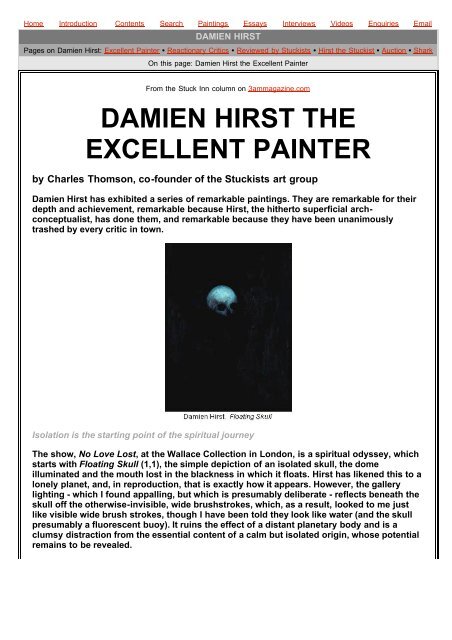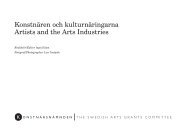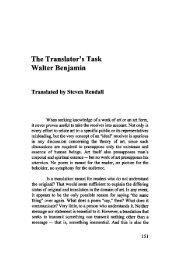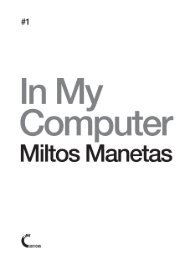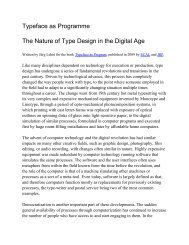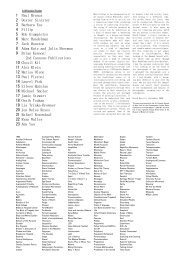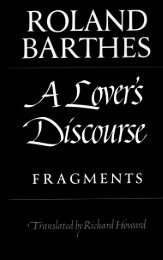Damien Hirst the Excellent Painter - Harald Peter Ström
Damien Hirst the Excellent Painter - Harald Peter Ström
Damien Hirst the Excellent Painter - Harald Peter Ström
You also want an ePaper? Increase the reach of your titles
YUMPU automatically turns print PDFs into web optimized ePapers that Google loves.
Home Introduction Contents Search Paintings Essays Interviews Videos Enquiries Email<br />
DAMIEN HIRST<br />
Pages on <strong>Damien</strong> <strong>Hirst</strong>: <strong>Excellent</strong> <strong>Painter</strong> • Reactionary Critics • Reviewed by Stuckists • <strong>Hirst</strong> <strong>the</strong> Stuckist • Auction • Shark<br />
On this page: <strong>Damien</strong> <strong>Hirst</strong> <strong>the</strong> <strong>Excellent</strong> <strong>Painter</strong><br />
From <strong>the</strong> Stuck Inn column on 3ammagazine.com<br />
DAMIEN HIRST THE<br />
EXCELLENT PAINTER<br />
by Charles Thomson, co-founder of <strong>the</strong> Stuckists art group<br />
<strong>Damien</strong> <strong>Hirst</strong> has exhibited a series of remarkable paintings. They are remarkable for <strong>the</strong>ir<br />
depth and achievement, remarkable because <strong>Hirst</strong>, <strong>the</strong> hi<strong>the</strong>rto superficial archconceptualist,<br />
has done <strong>the</strong>m, and remarkable because <strong>the</strong>y have been unanimously<br />
trashed by every critic in town.<br />
Isolation is <strong>the</strong> starting point of <strong>the</strong> spiritual journey<br />
The show, No Love Lost, at <strong>the</strong> Wallace Collection in London, is a spiritual odyssey, which<br />
starts with Floating Skull (1,1), <strong>the</strong> simple depiction of an isolated skull, <strong>the</strong> dome<br />
illuminated and <strong>the</strong> mouth lost in <strong>the</strong> blackness in which it floats. <strong>Hirst</strong> has likened this to a<br />
lonely planet, and, in reproduction, that is exactly how it appears. However, <strong>the</strong> gallery<br />
lighting - which I found appalling, but which is presumably deliberate - reflects beneath <strong>the</strong><br />
skull off <strong>the</strong> o<strong>the</strong>rwise-invisible, wide brushstrokes, which, as a result, looked to me just<br />
like visible wide brush strokes, though I have been told <strong>the</strong>y look like water (and <strong>the</strong> skull<br />
presumably a fluorescent buoy). It ruins <strong>the</strong> effect of a distant planetary body and is a<br />
clumsy distraction from <strong>the</strong> essential content of a calm but isolated origin, whose potential<br />
remains to be revealed.
A self-portrait: this is <strong>the</strong> artist's inner world and, he insinuates, ours<br />
This potential begins to emerge in some small works measuring 24" x 16", where <strong>the</strong> skull<br />
is set in a simple context of thin lines or rows of small circles. These cautious forays gain<br />
in confidence, direction and complexity in bigger paintings, measuring up to 40" x 30", <strong>the</strong><br />
most significant of <strong>the</strong>m on <strong>the</strong> opposite wall to <strong>the</strong> small works. A key development is <strong>the</strong><br />
outline of a table top in <strong>the</strong> bottom half of <strong>the</strong> canvas. This gives a geographical location,<br />
suggestive of <strong>the</strong> home or studio environment of <strong>the</strong> artist. The skull is not one of a corpse,<br />
but a self-portrait, demonstrating that externals have been stripped away and we have<br />
entered <strong>the</strong> artist's inner reality, where <strong>the</strong> material world is experienced more as a<br />
phantasm than a solidity, as shown by <strong>the</strong> thin outlines of an ashtray or cigarette packet<br />
resting on <strong>the</strong> equally insubstantial table. The skull's sardonic expression in Skull with<br />
Ashtray, Lemon and Cigarettes (11, 4) inquires if we recognise that this is our reality as<br />
well.<br />
The technical painting of <strong>the</strong> skulls is a combination of suggestion and definition.<br />
Ambiguous marks suggest ei<strong>the</strong>r sockets or eyes, and it is <strong>the</strong> viewer's mind that will make<br />
<strong>the</strong> interpretation. Some of <strong>the</strong> background of <strong>the</strong> work has an effect comparable to a wiped<br />
blackboard but with <strong>the</strong> chalk leaving a misty remnant. An obviously discordant feature is<br />
<strong>the</strong> bright yellow shape of a lemon. It undermines <strong>the</strong> nihilistic complacency of <strong>the</strong><br />
proposition that <strong>the</strong> world is merely spectral, with a vividness of colour testifying that <strong>the</strong><br />
material reality of <strong>the</strong> senses cannot be so easily disposed of. It poses <strong>the</strong> question of how<br />
two such seemingly different dimensions can co-exist, but does not find a resolution. The<br />
yellow paint works aes<strong>the</strong>tically because it has been applied with just <strong>the</strong> right touch to<br />
leave a slight coarseness round <strong>the</strong> edges. The cigarette in Skull with Ashtray, Lemon and<br />
Cigarettes (11, 4) is delicately captured, whereas <strong>the</strong> pink lighter is a crude layer of paint<br />
which fails to define its subject.<br />
The top area of <strong>the</strong> paintings is marked out decoratively with restrained rows of circles,<br />
dots or diamonds. White lines animate <strong>the</strong> surface, while evidencing <strong>the</strong> attempt to make<br />
sense of reality by searching for connections within it. The untroubled void of empty space<br />
in <strong>the</strong> first painting in <strong>the</strong> show has been relinquished for <strong>the</strong> yearning to find meaning. The<br />
lines are evocative, when <strong>the</strong>y are applied with focused care: <strong>the</strong> best in this respect are<br />
Small Skull with Lemon and Ashtray (12, 2), Skull with Ashtray, Lemon and Cigarettes (11,<br />
4) and particularly Glass of Water and Ashtray (14, 8). <strong>Hirst</strong> is a psychologically accurate<br />
painter and succeeds technically when he paints with deliberation, but lacks virtuoso
painter and succeeds technically when he paints with deliberation, but lacks virtuoso<br />
technique, and even small deviations into showmanship fall short. (A disastrously<br />
slapdash, but fortunately small, painting, Skull (13, 19) from 2008, on <strong>the</strong> far end wall of <strong>the</strong><br />
show shows how easily he can lose his way.)<br />
A projection of lines in a pie-slice shape coming out of <strong>the</strong> skull in Skull with Ashtray and<br />
Lemon (10, 3) is a wobbly irrelevance, which, along with an misjudged small diamond<br />
interrupting <strong>the</strong> vertical line to <strong>the</strong> right of <strong>the</strong> skull, weakens an o<strong>the</strong>rwise strong painting.<br />
Skull with Ashtray, Cigarettes, Lighter and Shell (9, 5) culminates in a frenetic rationality<br />
with a maze of lines, which threaten to annihilate any coherence. It is unfortunate that this<br />
effect is undermined by poor application, so <strong>the</strong> psychological impact of <strong>the</strong> lines takes<br />
second place to <strong>the</strong> lazy white paint marks and <strong>the</strong> inept outlines of rectangles and<br />
diamonds <strong>the</strong>y define. The delicate tints of <strong>the</strong> shell hint at a direction which could be<br />
explored much fur<strong>the</strong>r.<br />
A less insightful individual and less disciplined artist might well have been captivated by<br />
<strong>the</strong> attraction of this mesh of lines and developed it into fur<strong>the</strong>r abstraction. This is <strong>the</strong><br />
point where art becomes artificial and divorced from purposeful engagement. It is very<br />
much to <strong>Hirst</strong>'s credit that he dismisses such temptation in <strong>the</strong> works which follow, and<br />
instead uses visual means to externalise inner states.<br />
The paintings described so far (apart from Skull (13, 19)) were made 2006 - 2007. They<br />
certainly have interest and accomplishment, although <strong>the</strong>re is at times a hit and miss<br />
quality to this. The following paintings from 2008, increasingly dramatically in size up to<br />
80" x 51", represent a major achievement. However, on my first visit to <strong>the</strong> show, I felt <strong>the</strong>y<br />
were not successful and wrote that <strong>the</strong>y had "generally overstretched his abilities." It was<br />
only on my second visit that I could appreciate <strong>the</strong>ir classical and monumental presence,<br />
and even more so during a third visit.<br />
A masterpiece which defines <strong>the</strong> limits of rationality and asceticism<br />
One series continues to use <strong>the</strong> central motif of <strong>the</strong> skull, and six of <strong>the</strong>se paintings are<br />
arranged as triptychs, <strong>the</strong> masterpiece being Men Shall Know Nothing (19, 6), which has<br />
one skull in each of <strong>the</strong> three canvases and evokes <strong>the</strong> asceticism of a mediaeval monk's<br />
cell. Any excess in <strong>the</strong> earlier work has been shaved away; <strong>the</strong> skull represents humanity at<br />
<strong>the</strong> edge of mortality. The top half of each black-blue canvas is covered with a grid of white<br />
spots, which tap out a relentless pattern like <strong>the</strong> clockwork passage of time, making<br />
measurement but not meaning.<br />
The white lines have <strong>the</strong> fineness of scalpel cuts, running vertically like scratches on an old<br />
film, or radiating with nervous energy from <strong>the</strong> central skull with <strong>the</strong> precision of radio<br />
waves sent into space and failing to find reciprocation from any distant form of life. There<br />
is never<strong>the</strong>less a strong feeling of self possession and resolution, derived from taking <strong>the</strong>
is never<strong>the</strong>less a strong feeling of self possession and resolution, derived from taking <strong>the</strong><br />
path of self-denial to this extreme, and learning that <strong>the</strong>re is nothing more that can be<br />
gained from travelling fur<strong>the</strong>r along it.<br />
The barely, but neatly, defined table top remains a symbol of <strong>the</strong> domestic. The smudged<br />
traces of disconnected spinal columns bookend <strong>the</strong> triptych, and hints of dark green<br />
foliage at <strong>the</strong> bottom of each picture are a reminder of a hardly accessible natural world.<br />
The triptych is a towering, albeit severe, achievement.<br />
The Meek Shall Inherit <strong>the</strong> Earth (2, 7) is <strong>the</strong> o<strong>the</strong>r triptych, and, while not quite attaining <strong>the</strong><br />
formal perfection of Men Shall Know Nothing, is also monumental, consisting of just a skull<br />
in each painting (along with a yawning shark's jaw in <strong>the</strong> right hand painting) with spectral<br />
white lines, which seem on <strong>the</strong> point of dematerialising along with <strong>the</strong> occasional faint<br />
objects <strong>the</strong>y indicate - a table top, a glass, a beetle, and, at <strong>the</strong> bottom of <strong>the</strong> central<br />
painting, what looks like a death mask in an embryonic sac, barely discernible and even<br />
less so in reproduction. (It is worth mentioning that many of <strong>the</strong>se paintings do not<br />
reproduce well and <strong>the</strong> dark shades lose <strong>the</strong>ir impact in print form.) The lines make varied<br />
and inventive divisions of <strong>the</strong> picture surface, and <strong>the</strong>ir irregular thinness creates a quiet<br />
tension.<br />
O<strong>the</strong>r paintings in this series are of less significance, being subsidiary explorations of<br />
similar <strong>the</strong>mes. They incorporate a skull, an iguana, and what looks like shark dentures.<br />
Whereas <strong>the</strong> use of gridded spots is a masterful transformative quotation from his earlier<br />
conceptual work, <strong>the</strong> shark jaws do not transfer so well into two dimensions, and seem<br />
more <strong>the</strong> remnant of old habits. Their white oval ring sits slightly uncomfortably in <strong>the</strong><br />
composition and adds nothing to <strong>the</strong> meaning of <strong>the</strong> work. <strong>Hirst</strong> may have been drawn,<br />
whe<strong>the</strong>r consciously or unconsciously, to an echo of <strong>the</strong> screaming mouth in Francis<br />
Bacon's Study after Velazquez's Portrait of Pope Innocent X, but, if so, it is a pun that<br />
distracts from his real purpose.<br />
Skull, Shark's Jaw and Iguana on a Table (21, 13) is sufficient, while its neighbouring work,<br />
Shark's Jaw, Skull and Iguana on a Table (23, 14) is near-identical, but with <strong>the</strong> components<br />
clumsily pushed toge<strong>the</strong>r. Iguana with Skull and Shark's Jaw (22, 16) repeats <strong>the</strong><br />
arrangement, but with a second row of teeth in <strong>the</strong> middle of <strong>the</strong> open shape of <strong>the</strong> shark's<br />
jaw, so that it looks as though somebody had accidentally used Photoshop's cloning tool. It<br />
is a not very clever cleverness of <strong>the</strong> kind that <strong>Hirst</strong> needs to avoid. When he does, as in<br />
Shark's Jaw and Iguana (24, 15), he again achieves an enduring image, albeit a tad<br />
weakened by his decision to colour <strong>the</strong> tail with Naples yellow. This is also done in <strong>the</strong><br />
previous three paintings mentioned, where it is even more out of place, an arbitrary<br />
intrusion, not being justified ei<strong>the</strong>r in terms of meaning or aes<strong>the</strong>tics, and representing only<br />
ano<strong>the</strong>r unsuccessful tentative attempt at a bravura touch.
The confrontation with pagan power antipodal to western Christian culture<br />
A slightly dreamy, wistful and folklorish medium size painting, Woman of <strong>the</strong> Woods (3, 21)<br />
leads into a set of four large works, which seem at first sight to be straight out of <strong>the</strong><br />
studios of Abstract Expressionism, but of a dark intensity, which makes most works of that<br />
school look like kindergarten colouring books and even Rothko's sombre effusions<br />
lightweight in comparison. The large skull-<strong>the</strong>med paintings of a Christ-less, Christian,<br />
ascetic and rational spirituality have here <strong>the</strong>ir counterbalance in depictions of a primeval,<br />
pagan, purposeful, but seemingly amoral and formless, power.<br />
These are, however, figurative paintings, and in The Birth of Medusa (4, 24) <strong>the</strong> trunks of<br />
trees rise to <strong>the</strong> top of <strong>the</strong> painting like flames turned to ice, while a shape in <strong>the</strong> centre of<br />
<strong>the</strong> image is roughed in with a raw red, suggestive of some corporeal vestige, a bloody<br />
embryo or a flayed heart. Thin lines descend like white hot wires. A dark vertical stripe<br />
bisects <strong>the</strong> painting (as it does with <strong>the</strong> three companion paintings) like a dark generative<br />
power from - or a narrow doorway to - an even denser primordial level. When I first saw it, I<br />
forgot <strong>the</strong> genteel surroundings and entered <strong>the</strong> reality of <strong>the</strong> painting to be struck by a<br />
moment of fear.<br />
Ei<strong>the</strong>r side of this painting are Guardian I (6, 25) and Guardian II (7, 23). Both are more<br />
complex than The Birth of Medusa and contain <strong>the</strong> vestiges of <strong>the</strong> grid of spots which <strong>the</strong><br />
central painting does not have. More disturbing is <strong>the</strong> apparition in Witness at <strong>the</strong> Birth of<br />
Medusa (5, 22), where <strong>the</strong> barely-discernable form of <strong>the</strong> witness is almost effaced by<br />
shredded trees and incessant vertical lines like razors slashing <strong>the</strong> air and dismembering<br />
<strong>the</strong> comprehension of <strong>the</strong> figure in <strong>the</strong> face of what he encounters. The v-shape of what<br />
appears to <strong>the</strong> beating wings of a bird are above him, ei<strong>the</strong>r descending with unseen claws<br />
about to sink into invisible eyes or arising as <strong>the</strong> dark messenger of what has been<br />
witnessed. At <strong>the</strong> bottom of <strong>the</strong> picture <strong>the</strong>re is <strong>the</strong> faintest outline of a table and an<br />
ashtray. The witness is <strong>the</strong> artist and <strong>the</strong> setting is where it has been all along, in <strong>the</strong><br />
familiar everyday, which almost disintegrates in this near-psychotic storm.
The resolution of a spiritual journey, <strong>the</strong> cosmic in <strong>the</strong> mundane<br />
<strong>Hirst</strong> has already declared an agenda of "going more towards Rembrandt and away from<br />
Bacon". Rembrandt is noted for his integration of darkness and light. At <strong>the</strong> end of <strong>the</strong><br />
show, <strong>Hirst</strong>'s Requiem, White Roses and Butterflies (25, 20), celebrates <strong>the</strong> grail attained at<br />
<strong>the</strong> end of a spiritual odyssey. The continuation of <strong>the</strong> colours of dark blue and white relate<br />
<strong>the</strong> painting to <strong>the</strong> rest of <strong>the</strong> exhibition. The starting motif of <strong>the</strong> skull has been<br />
transubstantiated into a spray of white roses in a vase, which takes its place alongside<br />
settled outlines of a glass of liquid and a cigarette packet on a table top. The constellation<br />
of butterflies across <strong>the</strong> dark depths of <strong>the</strong> background creates <strong>the</strong> effect of a star-filled<br />
sky, or <strong>the</strong> emanative force at <strong>the</strong> creation of <strong>the</strong> universe. It is a visual equivalent to<br />
Blake's "Auguries of Innocence":<br />
To see a World in a Grain of Sand<br />
And a Heaven in a Wild Flower,<br />
Hold Infinity in <strong>the</strong> palm of your hand<br />
And Eternity in an hour.<br />
After <strong>the</strong> bleak purgatorial journey and <strong>the</strong> dark night of <strong>the</strong> soul, where everything nonessential<br />
was stripped away and inhuman power was confronted face to face, it is a<br />
celebration of joy, beauty and wonder, a spiritual healing and illumination. The requiem is<br />
for <strong>the</strong> death of death.<br />
<strong>Hirst</strong>'s previous conceptual oeuvre stands in contrast to this work as a series of studies for<br />
it - literally <strong>the</strong> concepts which now inform his paintings, where <strong>the</strong> infinitely more subtle<br />
and flexible capability of paint is able to bring his meaning into fruition with a previously<br />
unachievable clarity and force of expression. In order to do this, he has on <strong>the</strong> whole wisely<br />
recognised as a painter his limitations, within which he has defined and mastered <strong>the</strong><br />
approaches and motifs necessary to realise a highly focused vision. This is not <strong>the</strong> end of<br />
<strong>the</strong> journey, or even <strong>the</strong> map for it, but ra<strong>the</strong>r a first step from one stage of personal and<br />
artistic life to <strong>the</strong> next. As an initial body of paintings it is an outstanding achievement.<br />
The numbering in <strong>the</strong> book "No Love Lost" differs for most paintings from <strong>the</strong> show numbering.<br />
The numbers in brackets show <strong>the</strong> book number first and <strong>the</strong> show number second.<br />
See also:<br />
<strong>Damien</strong> <strong>Hirst</strong> and <strong>the</strong> Reactionary Critics
<strong>Damien</strong> <strong>Hirst</strong>'s Paintings Reviewed by Stuckists<br />
<strong>Damien</strong> <strong>Hirst</strong> <strong>the</strong> Stuckist<br />
back to top


